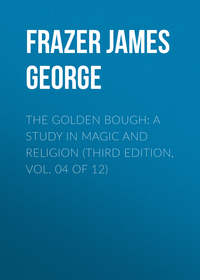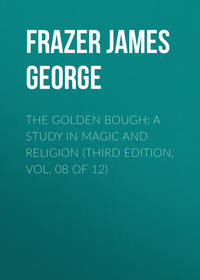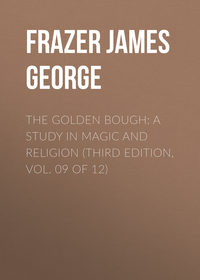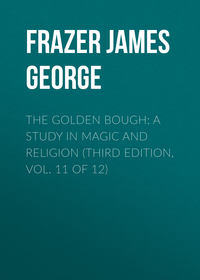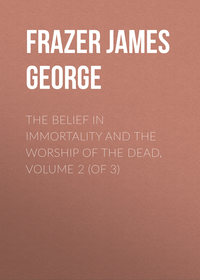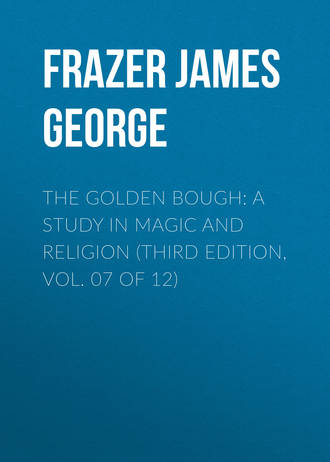 полная версия
полная версияThe Golden Bough: A Study in Magic and Religion (Third Edition, Vol. 07 of 12)
525
Folk-lore Journal, vi. (1888) pp. 268 sq.
526
The late Mrs. Macalister, wife of Professor Alexander Macalister, Cambridge. Her recollections referred especially to the neighbourhood of Glen Farg, some ten or twelve miles to the south of Perth.
527
Rev. James Macdonald, Religion and Myth (London, 1893), pp. 141 sq.
528
From information supplied by Archie Leitch, late gardener to my father at Rowmore, Garelochhead. The Kirn was the name of the harvest festivity in the south of Scotland also. See Lockhart's Life of Scott, ii. 184 (first edition); Early Letters of Thomas Carlyle, ed. Norton, ii. 325 sq.
529
Communicated by the late Mr. Macfarlane of Faslane, Gareloch.
530
A slightly different mode of making up the clyack sheaf is described by the Rev. Walter Gregor elsewhere (Notes on the Folk-lore of the North-east of Scotland, London, 1881, pp. 181 sq.): “The clyack sheaf was cut by the maidens on the harvest field. On no account was it allowed to touch the ground. One of the maidens seated herself on the ground, and over her knees was the band of the sheaf laid. Each of the maidens cut a handful, or more if necessary, and laid it on the band. The sheaf was then bound, still lying over the maiden's knees, and dressed up in woman's clothing.”
531
W. Gregor, “Quelques coutumes du Nord-est du Comté d'Aberdeen,” Revue des Traditions populaires, iii. (October, 1888) pp. 484-487 (wrong pagination; should be 532-535). This account, translated into French by M. Loys Brueyre from the author's English and translated by me back from French into English, is fuller than the account given by the same writer in his Notes on the Folk-lore of the North-east of Scotland (London, 1881), pp. 181-183. I have translated “une jument ayant son poulain” by “a mare in foal,” and “la plus ancienne vache ayant son veau” by “the oldest cow in calf,” because in the author's Notes on the Folk-lore of the North-east of Scotland (p. 182) we read that the last sheaf was “carefully preserved till Christmas or New Year morning. On that morning it was given to a mare in foal,” etc. Otherwise the French words might naturally be understood of a mare with its foal and a cow with its calf.
532
See above, pp. 115 sq.
533
See below, vol. ii. p. 110.
534
The drinking of the draught (called the κυκεών) as a solemn rite in the Eleusinian mysteries is mentioned by Clement of Alexandria (Protrept. 21, p. 18, ed. Potter) and Arnobius (Adversus Nationes, v. 26). The composition of the draught is revealed by the author of the Homeric Hymn to Demeter (verses 206-211), where he represents Demeter herself partaking of the sacred cup. That the compound was a kind of thick gruel, half-solid, half-liquid, is mentioned by Eustathius (on Homer, Iliad, xi. 638, p. 870). Compare Miss J. E. Harrison, Prolegomena to the Study of Greek Religion, Second Edition (Cambridge, 1908), pp. 155 sqq.
535
Rev. J. Macdonald, Religion and Myth (London, 1893), pp. 140 sq., from MS. notes of Miss J. Ligertwood.
536
Folk-lore Journal, vii. (1889) p. 51; The Quarterly Review, clxxii. (1891) p. 195.
537
As to Inverness-shire my old friend Mr. Hugh E. Cameron, formerly of Glen Moriston, Inverness-shire, wrote to me many years ago: “As a boy, I remember the last bit of corn cut was taken home, and neatly tied up with a ribbon, and then stuck up on the wall above the kitchen fire-place, and there it often remained till the ‘maiden’ of the following year took its place. There was no ceremony about it, beyond often a struggle as to who would get, or cut, the last sheaf to select the ‘maiden’ from” (The Folk-lore Journal, vii. 1889, pp. 50 sq.). As to Sutherlandshire my mother was told by a servant, Isabella Ross, that in that county “they hang up the ‘maiden’ generally over the mantel-piece (chimney-piece) till the next harvest. They have always a kirn, whipped cream, with often a ring in it, and sometimes meal sprinkled over it. The girls must all be dressed in lilac prints, they all dance, and at twelve o'clock they eat potatoes and herrings” (op. cit. pp. 53 sq.).
538
W. Mannhardt, Die Korndämonen (Berlin, 1868), p. 30.
539
W. Müller, Beiträge zur Volkskunde der Deutschen in Mähren (Vienna and Olmütz, 1893), p. 327.
540
J. E. Waldfreund, “Volksgebräuche und Aberglaube in Tirol und dem Salzburger Gebirg,” Zeitschrift für deutsche Mythologie und Sittenkunde, iii. (1855) p. 340.
541
Th. Vernaleken, Mythen und Bräuche des Volkes in Oesterreich (Vienna, 1859), p. 310.
542
Mr. R. Matheson, in The Folk-lore Journal, vii. (1889) pp. 49, 50.
543
W. Mannhardt, Die Korndämonen (Berlin, 1868), p. 30.
544
E. Sommer, Sagen, Märchen und Gebräuche aus Sachsen und Thüringen (Halle, 1846), pp. 160 sq.; W. Mannhardt, l. c.
545
W. Mannhardt, l. c.; E. Peter, Volksthümliches aus Österreichisch-Schlesien (Troppau, 1865-1867), ii. 269.
546
Alexander Nicolson, A Collection of Gaelic Proverbs and Familiar Phrases, based on Macintosh's Collection (Edinburgh and London, 1881), p. 248.
547
A. Nicolson, op. cit. pp. 415 sq.
548
R. C. Maclagan, “Corn-maiden in Argyleshire,” Folk-lore, vii. (1896) pp. 78 sq.
549
See above, p. 149, where, however, the corn-spirit is conceived as an Old Man.
550
See The Magic Art and the Evolution of Kings, ii. 73 sqq.
551
Above, pp. 134, 137, 138 sq., 142, 145, 147, 148, 149.
552
See below, pp. 237 sq.
553
The Magic Art and the Evolution of Kings, ii. 47 sqq.
554
Above, pp. 134, 135.
555
Above, pp. 141, 155, 156, 158, 160 sq., 162, 165.
556
See above, p. 135.
557
Above, p. 145. Compare A. Kuhn, Sagen, Gebräuche und Märchen aus Westfalen (Leipsic, 1859), ii. p. 185, § 516.
558
Above, pp. 136, 139, 155, 157 sq., 162; compare p. 160.
559
The Magic Art and the Evolution of Kings, i. 220 sqq.
560
Above, p. 146. The common custom of wetting the last sheaf and its bearer is no doubt also a rain-charm; indeed the intention to procure rain or make the corn grow is sometimes avowed. See above, pp. 134, 137, 143, 144, 145; Adonis, Attis, Osiris, Second Edition, pp. 195-197.
561
Above, pp. 135 sq., 138, 139, 152.
562
Above, p. 134.
563
Above, pp. 134, 155, 158, 161.
564
Above, pp. 136, 138, 140, 143, 152, 153, 154, 155, 156, 157, 158: W. Mannhardt, Die Korndämonen, pp. 7, 26.
565
J. de Acosta, Natural and Moral History of the Indies, bk. v. ch. 28, vol. ii. p. 374 (Hakluyt Society, London, 1880). In quoting the passage I have modernised the spelling. The original Spanish text of Acosta's work was reprinted in a convenient form at Madrid in 1894. See vol. ii. p. 117 of that edition.
566
W. Mannhardt, Mythologische Forschungen, pp. 342 sq. Mannhardt's authority is a Spanish tract (Carta pastorale de exortacion e instruccion contra las idolatrias de los Indios del arçobispado de Lima) by Pedro de Villagomez, Archbishop of Lima, published at Lima in 1649, and communicated to Mannhardt by J. J. v. Tschudi. The Carta Pastorale itself seems to be partly based on an earlier work, the Extirpacion de la Idolatria del Piru. Dirigido al Rey N.S. en Su real conseio de Indias, por el Padre Pablo Joseph de Arriaga de la Compañia de Jesus (Lima, 1621). A copy of this work is possessed by the British Museum, where I consulted it. The writer explains (p. 16) that the Maize-mothers (Zaramamas) are of three sorts, namely (1) those which are made of maize stalks, dressed up like women, (2) those which are carved of stone in the likeness of cobs of maize, and (3) those which consist simply of fruitful stalks of maize or of two maize-cobs naturally joined together. These last, the writer tells us, were the principal Zaramamas, and were revered by the natives as Mothers of the Maize. Similarly, when two potatoes were found growing together the Indians called them Potato-mothers (Axomamas) and kept them in order to get a good crop of potatoes. As Arriaga's work is rare, it may be well to give his account of the Maize-mothers, Coca-mothers, and Potato-mothers in his own words. He says (p. 16): “Zaramamas, son de tres maneras, y son las que se quentan entre las cosas halladas en los pueblos. La primera es una como muñeca hecha de cañas de maiz, vestida como muger con su anaco, y llicilla, y sus topos de plata, y entienden, que como madre tiene virtud de engendrar, y parir mucho maiz. A este modo tienen tambien Cocamamas para augmento de la coca. Otras son de piedra labradas como choclos, o mazorcas de maiz, con sus granos relevados, y de estas suelen tener muchas en lugar de Conopas [household gods]. Otras son algunas cañas fertiles de maiz, que con la fertilidad de la tierra dieron muchas maçorcas, y grandes, o quando salen dos maçorcas juntas, y estas son las principales, Zaramamas, y assi las reverencian como a madres del maiz, a estas llaman tambien Huantayzara, o Ayrihuayzara. A este tercer genero no le dan la adoracion que a Huaca, ni Conopa, sino que le tienen supersticiosamente como una cosa sagrada, y colgando estas cañas con muchos choclos de unos ramos de sauce bailen con ellas el bayle, que llaman Ayrihua, y acabado el bayle, las queman, y sacrifican a Libiac para que les de buena cosecha. Con la misma supersticion guardan las mazorcas del maiz, que salen muy pintadas, que llaman Micsazara, o Mantayzara, o Caullazara, y otros que llaman Piruazara, que son otras maçorcas en que van subiendo los granos no derechos sino haziendo caracol. Estas Micsazara, o Piruazara, ponen supersticiosamente en los montones de maiz, y en las Piruas (que son donde guardan el maiz) paraque se las guarde, y el dia de las exhibiciones se junta tanto de estas maçorcas, que tienen bien que comer las mulas. La misma supersticion tienen con las que llaman Axomamas, que son quando salen algunas papas juntas, y las guardan para tener buena cosecha de papas.” The exhibiciones here referred to are the occasions when the Indians brought forth their idols and other relics of superstition and delivered them to the ecclesiastical visitors. At Tarija in Bolivia, down to the present time, a cross is set up at harvest in the maize-fields, and on it all maize-spadices growing as twins are hung. They are called Pachamamas (Earth-mothers) and are thought to bring good harvests. See Baron E. Nordenskiöld, “Travels on the Boundaries of Bolivia and Argentina,” The Geographical Journal, xxi. (1903) pp. 517, 518. Compare E. J. Payne, History of the New World called America (Oxford, 1892), i. 414 sq.
567
Brasseur de Bourbourg, Histoire des Nations civilisées du Mexique et de l'Amérique Centrale (Paris 1857-1859), iii. 40 sqq. Compare id., iii. 505 sq.; E. J. Payne, History of the New World called America, i. 419 sq.
568
E. Seler, “Altmexikanische Studien, ii.,” Veröffentlichungen aus dem königlichen Museum für Völkerkunde, vi. (Berlin, 1899) 2/4 Heft, pp. 67 sqq. Another chapter of Sahagun's work, describing the costumes of the Mexican gods, has been edited and translated into German by Professor E. Seler in the same series of publications (“Altmexikanische Studien,” Veröffentlichungen aus dem königlichen Museum für Völkerkunde, i. 4 (Berlin, 1890) pp. 117 sqq.). Sahagun's work as a whole is known to me only in the excellent French translation of Messrs. D. Jourdanet and R. Simeon (Histoire Générale des choses de la Nouvelle-Espagne par le R. P. Fray Bernardino de Sahagun, Paris, 1880). As to the life and character of Sahagun see M. R. Simeon's introduction to the translation, pp. vii. sqq.
569
B. de Sahagun, Aztec text of book ii., translated by Professor E. Seler, “Altmexikanische Studien, ii.,” Veröffentlichungen aus dem königlichen Museum für Völkerkunde, vi. 2/4 Heft (Berlin, 1899), pp. 188-194. The account of the ceremonies given in the Spanish version of Sahagun's work is a good deal more summary. See B. de Sahagun, Histoire Générale des choses de la Nouvelle Espagne (Paris, 1880), pp. 94-96.
570
J. Mooney, “Myths of the Cherokee,” Nineteenth Annual Report of the Bureau of American Ethnology, Part I. (Washington, 1900) pp. 423, 432. See further Adonis, Attis, Osiris, Second Edition, pp. 296 sq.
571
L. H. Morgan, League of the Iroquois (Rochester, 1851), pp. 161 sq., 199. According to the Iroquois the corn plant sprang from the bosom of the mother of the Great Spirit after her burial (L. H. Morgan, op. cit. p. 199 note 1).
572
C. Lumholtz, Unknown Mexico (London, 1903), ii. 280.
573
H. M. Elliot, Supplemental Glossary of Terms used in the North-Western Provinces, edited by J. Beames (London, 1869), i. 254.
574
W. B. Harris, “The Berbers of Morocco,” Journal of the Anthropological Institute, xxvii. (1898) p. 68.
575
Sir John Drummond Hay, Western Barbary, its Wild Tribes and Savage Animals (1844), p. 9, quoted in Folk-lore, vii. (1896) pp. 306 sq.
576
See above, pp. 70 sqq.
577
R. J. Wilkinson (of the Civil Service of the Federated Malay States), Malay Beliefs (London and Leyden, 1906), pp. 49-51. On the conception of the soul as a bird, see Taboo and the Perils of the Soul, pp. 33 sqq. The Toradjas of Central Celebes think that the soul of the rice is embodied in a pretty little blue bird, which builds its nest in the rice-field when the ears are forming and vanishes after harvest. Hence no one may drive away, much less kill, these birds; to do so would not only injure the crop, the sacrilegious wretch himself would suffer from sickness, which might end in blindness. See A. C. Kruyt, “De Rijstmoeder in den Indischen Archipel,” p. 374 (see the full reference in the next note).
578
A. C. Kruyt, “De Rijstmoeder in den Indischen Archipel,” Verslagen en Mededeelingen der koninklijke Akademie van Wetenschappen, Afdeeling Letterkunde, Vierde Reeks, v. part 4 (Amsterdam, 1903), pp. 361 sq. This essay (pp. 361-411) contains a valuable collection of facts relating to what the writer calls the Rice-mother in the East Indies. But it is to be observed that while all the Indonesian peoples seem to treat a certain portion of the rice at harvest with superstitious respect and ceremony, only a part of them actually call it “the Rice-mother.” Mr. Kruyt prefers to speak of “soul-stuff” rather than of “a soul,” because, according to him, in living beings the animating principle is conceived, not as a tiny being confined to a single part of the body, but as a sort of fluid or ether diffused through every part of the body. See his work, Het Animisme in den Indischen Archipel (The Hague, 1906), pp. 1 sqq. In the latter work (pp. 145-150) the writer gives a more summary account of the Indonesian theory of the rice-soul.
579
See The Magic Art and the Evolution of Kings, ii. 28 sq.; A. C. Kruyt, “De Rijstmoeder,” op. cit. pp. 363 sq., 370 sqq.
580
See above, pp. 113 sqq.
581
See above, p. 181.
582
See Taboo and the Perils of the Soul, pp. 411 sq.; A. C. Kruyt, “De Rijstmoeder,” op. cit. p. 372.
583
See above, pp. 92 sqq.
584
A. W. Nieuwenhuis, Quer durch Borneo (Leyden, 1904-1907), i. 157 sq.
585
A. W. Nieuwenhuis, op. cit. i. 118-121. Compare id., In Centraal Borneo (Leyden, 1900), i. 154 sqq.
586
A similar belief probably explains the masked dances and pantomimes of many savage tribes. If that is so, it shews how deeply the principle of imitative magic has influenced savage religion.
587
A. W. Nieuwenhuis, Quer durch Borneo, i. 322-330. Compare id., In Centraal Borneo, i. 185 sq. As to the masquerades performed and the taboos observed at the sowing season by the Kayans of the Mendalam river, see above, pp. 94 sqq.
588
A. W. Nieuwenhuis, op. cit. i. 317.
589
Spenser St. John, Life in the Forests of the Far East2 (London, 1863), i. 187, 192 sqq.; W. Chalmers, quoted in H. Ling Roth's Natives of Sarawak and British North Borneo (London, 1896), i. 412-414.
590
Rev. E. B. Cross, “On the Karens,” Journal of the American Oriental Society, iv. (1854) p. 309.
591
(Sir) J. G. Scott and J. P. Hardiman, Gazetteer of Upper Burma and of the Shan States (Rangoon, 1900-1901), Part i. vol. i. p. 559.
592
J. Mooney, “Myths of the Cherokee,” Nineteenth Annual Report of the Bureau of American Ethnology, Part i. (Washington, 1900) p. 423. Compare Adonis, Attis, Osiris, Second Edition, pp. 296 sq.
593
(Sir) J. G. Scott and J. P. Hardiman, op. cit. Part ii. vol. i. p. 172.
594
From a letter written to me by Mr. J. S. Furnivall and dated Pegu Club, Rangoon, 6/6 (sic). Mr. Furnivall adds that in Upper Burma the custom of the Bonmagyi sheaf is unknown.
595
J. L. van der Toorn, “Het animisme bij den Minangkabauer der Padangsche Bovenlanden,” Bijdragen tot de Taal- Land- en Volkenkunde van Nederlandsch Indië, xxxix. (1890) pp. 63-65. In the charm recited at sowing the Rice-mother in the bed, I have translated the Dutch word stoel as “root,” but I am not sure of its precise meaning in this connexion. It is doubtless identical with the English agricultural term “to stool,” which is said of a number of stalks sprouting from a single seed, as I learn from my friend Professor W. Somerville of Oxford.
596
A. C. Kruijt, “Eenige ethnografische aanteekeningen omtrent de Toboengkoe en de Tomori,” Mededeelingen van wege het Nederlandsche Zendelinggenootschap, xliv. (1900) pp. 227, 230 sq.
597
See Taboo and the Perils of the Soul, pp. 411 sq.
598
A. C. Kruijt, op. cit. p. 228.
599
A. C. Kruijt, “Een en ander aangaande het geestelijk en maatschapelijk leven van den Poso-Alfoer,” Mededeelingen van wege het Nederlandsche Zendelinggenootschap, xxxix. (1895) pp. 142 sq.
600
G. Maan, “Eenige mededeelingen omtrent de zeden en gewoonten der Toerateya ten opzichte van den rijstbouw,” Tijdschrift voor Indische Taal- Land- en Volkenkunde, xlvi. (1903) pp. 330-337. The writer dates his article from Tanneteya (in Celebes?), but otherwise gives no indication of the geographical position of the people he describes. A similar omission is common with Dutch writers on the geography and ethnology of the East Indies, who too often appear to assume that the uncouth names of these barbarous tribes and obscure hamlets are as familiar to European readers as Amsterdam or the Hague. The Toerateyas whose customs Mr. Maan describes in this article are the inland inhabitants of Celebes. Their name Toerateyas or Toradjas signifies simply “inlanders” and is applied to them by their neighbours who live nearer the sea; it is not a name used by the people themselves. The Toradjas include many tribes and the particular tribe whose usages in regard to the Rice-mother are described in the text is probably not one of those whose customs and beliefs have been described by Mr. A. C. Kruijt in many valuable papers. See above, p. 183 note 1, and The Magic Art and the Evolution of Kings, i. 109 note 1.
601
M. Joustra, “Het leven, de zeden en gewoonten der Bataks,” Mededeelingen van wege het Nederlandsche Zendelinggenootschap, xlvi. (1902) pp. 425 sq.
602
J. H. Neumann, “Iets over den landbouw bij de Karo-Bataks,” Mededeelingen van wege het Nederlandsche Zendelinggenootschap, xlvi. (1902) pp. 380 sq. As to the employment in ritual of young people whose parents are both alive, see Adonis, Attis, Osiris, Second Edition, pp. 413 sqq.
603
A. L. van Hasselt, “Nota, betreffende de rijstcultuur in de Residentie Tapanoeli,” Tijdschrift voor Indische Taal- Land- en Volkenkunde, xxxvi. (1893) pp. 526-529; Th. A. L. Heyting, “Beschrijving der Onderafdeeling Groot- mandeling en Batangnatal,” Tijdschrift van het Nederlandsch Aardrijkskundig Genootschap, Tweede Serie, xiv. (1897) pp. 290 sq. As to the rule of sowing seed on a full stomach, which is a simple case of homoeopathic or imitative magic, see further The Magic Art and the Evolution of Kings, i. 136.
604
W. W. Skeat, Malay Magic (London, 1900), pp. 225 sq.
605
W. W. Skeat, Malay Magic, pp. 235-249.
606
See above, pp. 163 sq.
607
P. J. Veth, Java (Haarlem, 1875-1884), i. 524-526. The ceremony has also been described by Miss Augusta de Wit (Facts and Fancies about Java, Singapore, 1898, pp. 229-241), who lays stress on the extreme importance of the rice-harvest for the Javanese. The whole island of Java, she tells us, “is one vast rice-field. Rice on the swampy plains, rice on the rising ground, rice on the slopes, rice on the very summits of the hills. From the sod under one's feet to the verge of the horizon, everything has one and the same colour, the bluish-green of the young, or the gold of the ripened rice. The natives are all, without exception, tillers of the soil, who reckon their lives by seasons of planting and reaping, whose happiness or misery is synonymous with the abundance or the dearth of the precious grain. And the great national feast is the harvest home, with its crowning ceremony of the Wedding of the Rice” (op. cit. pp. 229 sq.). I have to thank my friend Dr. A. C. Haddon for directing my attention to Miss de Wit's book.


